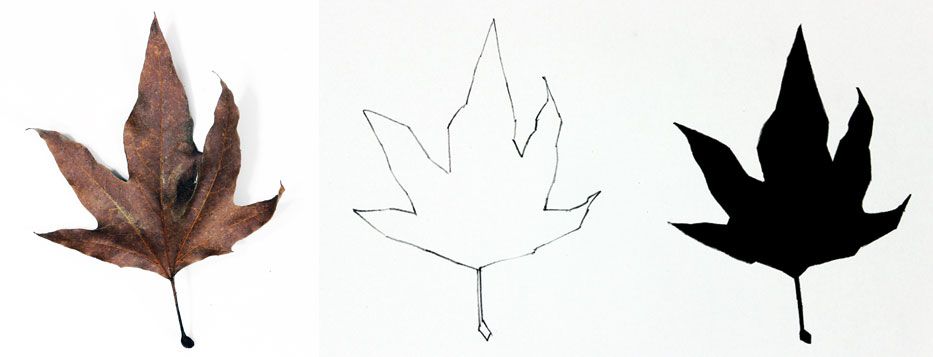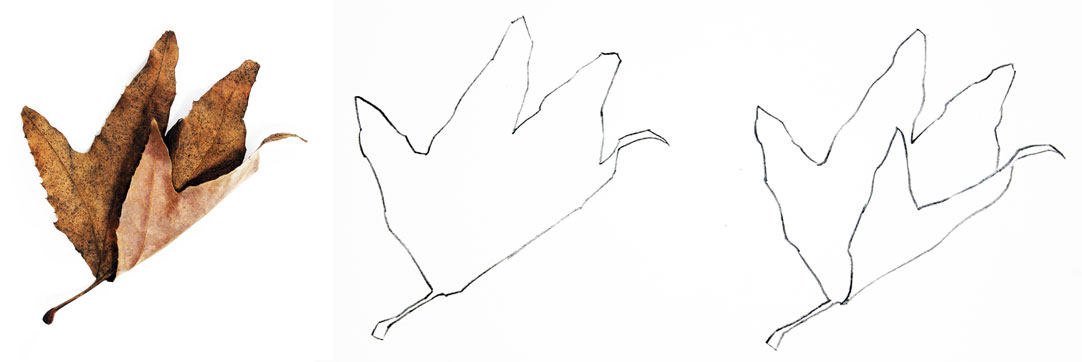The contour line is an important
concept that will make drawing a lot easier.

Contour line is a popular phrase and every drawing book seems to have a different definition of what it means.
Let’s look at my definition and how it pertains to these lessons.
I like to break contour into two categories.
1. Outer Contours - this is the outline or silhouette of an object. This can be either a line or a shape (like a piece of cutout construction paper).
|
Lets use a leaf as our subject |
Here is the outer contour as a line. |
Here it is as a shape. |
It’s important to note that in nature there are no lines or outlines; there is only shape (like the silhouette example). This is important when we get into painting where we deal primarily with shapes. But in drawing we use line to create our shapes. Don’t get confused between the two, for our purposes contour line and contour shape are the same thing.
2. Inner Contours - these are lines within the outline of an object. They come in a few different types.
- Decoration on the surface of an object (like a design painted on a vase)
- Texture or pattern (like a woven basket, or bark texture on a tree)
- Overlapping forms (a leaf turning in on itself, or overlapping parts of the body)
- Separate components within an object (windows on a building, doors on a car)
- And pretty much anything else that is within the outline of an object
 Decoration |
 Texture/Pattern |
 Separate Components |
|
Here is a leaf folded over on itself creating an overlapping form. |
Here is the outline shape of the leaf. |
Here is the inner contour line of the overlapping leaf form. |
|
Here is another example of overlapping forms. |
Here is the outline shape of the hand. |
Here are the inner contour lines defining the overlapping shapes. Note how I simplified the drawing and only indicated the dominant lines. |
A quick note about shadows.
I don't consider shadows to be contour lines at all. Shadows are their own element and are very important in showing the form of objects. We will get into detailed lessons about shadows in Drawing Essentials: Level 3. But for now just be aware that shadows are a separate drawing element.
Now that we have a definition for contour line,
how do we
use it to make drawing easier?
The key is to look past the inner contours at first and focus on the outer contour shape of the subject.
If you can see the big outer silhouette you can draw a simple containing shape to fit your subject into. Look at the image below. It’s easy to get overwhelmed by all the different lines and shapes.
Now focus on just the big outer shape (squinting will simplify the shapes and help you see the outline more clearly). Doesn’t this seem easier to draw. Take a look at the example. This is called blocking in a drawing.
(in an upcoming lesson we will look in detail at the block-in.)
I start by drawing the big general shape the best I can. Be aware that this is just my best first attempt. It might not be perfect and may have to be corrected. This is perfectly fine. This is what drawing is all about. Doing your best and fixing it as you go.
After I get the main block-in I can start breaking the large form into smaller inner shapes, making corrections along the way.
Being able to see the outer contour of your subjects will help you to identify the large overall shape and give you an easier starting point for your drawing.
I like to simplify a lot of the inner contours to just the essentials and often eliminate any pattern or texture.
How you choose to handle these elements will become part of your personal style. Try to draw inner contour elements different ways until you find just the right level of detail for you.
Another very important use of the contour is with composition. We will talk about composition in detail later but here are some good tips to remember.
When setting up a still life to draw look at the outline shape to pick the most interesting angle of your subject.
Be aware of bad tangencies (the line of one object awkwardly running into another object)
Even if you have drawn beautiful subjects, tangencies can easily wreck your drawing and make it look wrong. Look at the both the outer and dominant inner contours of your subjects to see if they are interacting negatively with each other.
Now that you know what contour line is and how it can help your drawing let’s take a look at the flip side of the contour coin. Negative space drawing.
Lesson 8: Negative Space Drawing
Home › Drawing Essentials: Level 1 › Lesson 7: Contour Line







